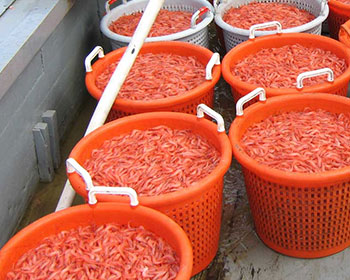
Shrimp capture. (Photo Credit: ODFW)
The Secretariat of Agriculture, Livestock, Rural Development, Fisheries and Food(SAGARPA) defined the temporary closure of all shrimp species from the Pacific Ocean and the Gulf of California as well as the estuarine lagoon systems, marshes and bays of the states Baja California Sur, Sonora, Sinaloa, Nayarit, Jalisco and Colima.
Together with the productive sector, the National Commission of Aquaculture and Fisheries (CONAPESCA) set the dates and production zones, taking into account the evaluations of the National Fisheries Institute (INAPESCA).
The measure extends as follows:
- In marine waters of the Gulf of California to the border between Nayarit and Jalisco (Cabo Corrientes) and in the waters of the estuarine lagoon systems, marshes and bays of the states of Sonora, Sinaloa and Nayarit, effective from 15 March, 2015 ;
- In marine waters off the west coast of the peninsula of Baja California, from the border with US to the point located at the geographic coordinates 22° 30' 00" north latitude and 109° 54' 45" west longitude and lagoon estuarine systems located in the state of Baja California Sur, as of 20 March;
- In marine waters from the border between the states of Nayarit and Jalisco to the border with Guatemala, including the estuarine lagoon systems of the state of Colima, effective from 30 March.
In the country, what is produced is whiteleg shrimp (Litopenaeus vannamei), blue shrimp (Litopenaeus stylirostris), yellowleg shrimp (Farfantepenaeus californiensis), Western white shrimp (Litopenaeus occidentalis), crystal shrimp (Farfantepenaeus brevirostris), Pacific seabob (Xiphopenaeus riveti), rock shrimp (Sicyonia disdorsalis andS. penicillata), Indio shrimp (Trachypenaeus faoe), royal red shrimp (Pleoticus robustus) and ‘botalón’ shrimp (Trachypenaus pacificus).
On the coast of the Pacific Ocean closures will have to contribute to the responsible exploitation of shrimp.
SAGARPA said in a statement that "the protection of the reproductive period, recruitment of specimens for the next season and securing reproductive remnant populations of species of crustaceans per zone by means of closures, is expected to ensure the reproduction and generate profits to tje sector, as well as sources of employment."
As long as when the ban starts, fishermen have shrimp from fishing in fresh state, iced, frozen, dried or in any other preservation form for wholesale or industrialization, they will have to create an inventory of the volumes they have.
Finally, last September a team of researchers from various scientific bodies began working on a project that aims at producing highly healthy and disease-resistant shrimp.
INAPESCA scientists, from the Centre for Food Research and Development (CIAD) andConsejo Nacional de Ciencia y Tecnología (CONACYT) attempt to decipher the genetic components associated with immunity to viral and bacterial diseases.
With the financial support of INAPESCA, CIAD researchers are working on the development of genomic tools that provide relevant data to counter shrimp diseases.
